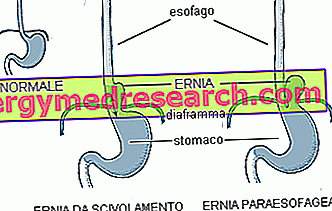Premise
In 9 cases out of 10, stomach cancer (or gastric tumor ) is an adenocarcinoma, a malignant tumor that originates from the epithelial cells of the gastric mucosa.

Stomach tumor symptoms
The symptoms of stomach cancer are slow to show. Moreover, a peculiarity of gastric neoplasms is precisely that of becoming symptomatic only after a very early symptom-free phase or characterized by non-specific clinical manifestations.
Specifically, at the onset of the asymptomatic post-phase symptomatology, the stomach-induced tumors are digestive in nature and consist mainly of:
- Sense of discomfort and fullness at the epigastrium (the region of the abdomen just below the sternum);
- Heartburn, which does not fade with gastric acidity;
- Episodes of indigestion;
- Food and acid regurgitation;
- belching;
- Bad digestion ( dyspepsia );
- Nausea and vomit. Vomiting often occurs after meals and contains solid food;
- Epigastric pain after meals;
- Alternation of diarrhea-constipation;
- Sensation of food blockage in the throat while eating ( dysphagia ). It suggests the presence of a stomach tumor very close to the esophagus.
Sometimes, these digestive disorders are associated with more general symptoms, such as:
- Easy fatigue;
- Episodes of fever;
- Weight loss;
- Anorexia (lack of appetite) generic or specific for a certain type of food (frequently it is towards the meat);
- Loss of desire to smoke (in smokers).
Therefore, as the neoplasm progresses, the whole symptomatology described so far inevitably worsens (ex: the anorexia towards the meat becomes real repugnance) and also appear:
- Edema (ie fluid retention with swelling) in various parts of the body, especially ankles. The cause of the edema is protein deficiency, due to their reduced dietary intake and / or their reduced absorption by the sick stomach;
- Vomiting with blood ( hematemesis ). It is due to tumors-induced internal hemorrhages;
- Digested blood in the stool. If the quantity of blood is conspicuous and the faeces are dark, one speaks more properly of melena; if instead the quantity of blood is small and the faeces do not appear particularly black, we speak more precisely of occult blood in the faeces .
- Oppressive pain behind the sternum;
- Pain in the lower part of the abdomen;
- Presence of a palpable swelling at the epigastrium level;
- Increased liver volume ( hepatomegaly );
- Iron deficiency anemia (ie from iron deficiency) and consequent pallor. Iron deficiency anemia is due to the lack of iron absorption in the sick stomach;
- Serious lack of strength;
- Ascites (fluid in the abdomen);
- Hyperpigmentation of the skin (in essence, the skin becomes darker).
Stage-by-phase symptoms of stomach cancer | |
| Phase | Symptomatic picture |
Very early stage or debut | Lack of non-specific symptoms or symptoms. |
Initial and intermediate phase | Digestive disorders:
General disorders:
|
Advanced stage | The digestive disorders of the initial phase get worse and those that were inconstant (that is, they came and went) are now stable Also, appear:
|
Complications
Having a malignant nature, stomach cancer can contaminate other organs and tissues of the human body with its "crazed" cells.
At an intermediate stage, contamination is limited to neighboring structures, such as pancreas, liver, colon, spleen, perigastric lymph nodes and large abdominal vessels; it is a contamination by contiguity, continuity and lymphatic pathways.
At an advanced stage, on the other hand, the contamination is decidedly more extensive and involves organs and lymph nodes distant from the site of tumor origin, such as the lungs, bones, brain, ovaries and lymph nodes of the upper part of the trunk (in particular those located on the left clavicle); in these situations, it is a contamination that occurs via the bloodstream, the lymphatic system and through the peritoneum.
Readers are reminded that tumor cells scattered elsewhere by a malign neoplasm are called metastases and that the process of dissemination of metastases ( metastasization ) is almost always lethal for those who are its victims.
Two curiosities:
- Metastases to the ovaries, which may derive for example from a stomach tumor, constitute a secondary malignant neoplasm known as Krukenberg tumor (NB: a tumor is said to be secondary when it is the result of neoplastic cells coming from other sites of the human body).
- To indicate the contamination of the lymph nodes of the left clavicle, by the metastases coming from an abdominal tumor like that of the stomach, is the increase in volume of these lymph nodes. The increase in volume of the lymph nodes of the left clavicle, due to a tumor, is called " Troisier sign " or " Virchow-Troisier lymph node ".
When should I go to the doctor?
According to experts, an individual should contact his or her treating physician when he or she is a victim of troubling digestive disorders that have no apparent cause.
The doctor will then investigate the precise cause of these disorders.
At their early stages, symptoms of stomach cancer could be confused with symptoms of viral gastroenteritis or gastric ulcer.



